 Anyone who edits biomedical research papers for a living will know that many scientists struggle to write clear, well-structured research papers that are easy to read. Many still insist on using an archaic writing style, filled with complicated prose that (they think) impresses their peers, instead of doing what they should do, which is focusing on their readers’ needs. They firmly believe that this is how scientists ‘should’ write, and that if they don’t write in this way, their papers will not sound important enough and will not be accepted for publication. This is what we, as editors of scientific papers, are up against.
Anyone who edits biomedical research papers for a living will know that many scientists struggle to write clear, well-structured research papers that are easy to read. Many still insist on using an archaic writing style, filled with complicated prose that (they think) impresses their peers, instead of doing what they should do, which is focusing on their readers’ needs. They firmly believe that this is how scientists ‘should’ write, and that if they don’t write in this way, their papers will not sound important enough and will not be accepted for publication. This is what we, as editors of scientific papers, are up against.
We must therefore find a solution to this problem. The truth is that this archaic style doesn’t only make scientific articles difficult to read – it actually gets in the way of reporting credible science.
Enter long-time SENSE member Ed Hull, with his latest book: Health-related Scientific Articles in the 21st Century: Give readers nuggets! In his book, Ed describes an easy-to-follow writing strategy that ensures precise, accurate and honest reporting of research findings. Ed shows scientists how to communicate credible research by focusing on specific take-home messages, or ‘core concepts’.
‘A good scientific article’, Ed says, ‘should teach the reader something’. And people learn better by grasping the core concepts before trying to understand the underlying details. Ed likens these core concepts to nuggets: ‘A nugget of gold is easy to pick up and has immediate value.’ In the context of scientific writing, an author can give their reader valuable nuggets of information to communicate what they want to say more clearly.
Cut to the core
In his book, Ed presents a template of 10 core concepts for research scientists to use when constructing their articles. This template structures the manuscript by bringing the take-home messages together. Core concepts 1–5 form the structure of the Introduction and core concepts 6–10 build the Discussion (see below).
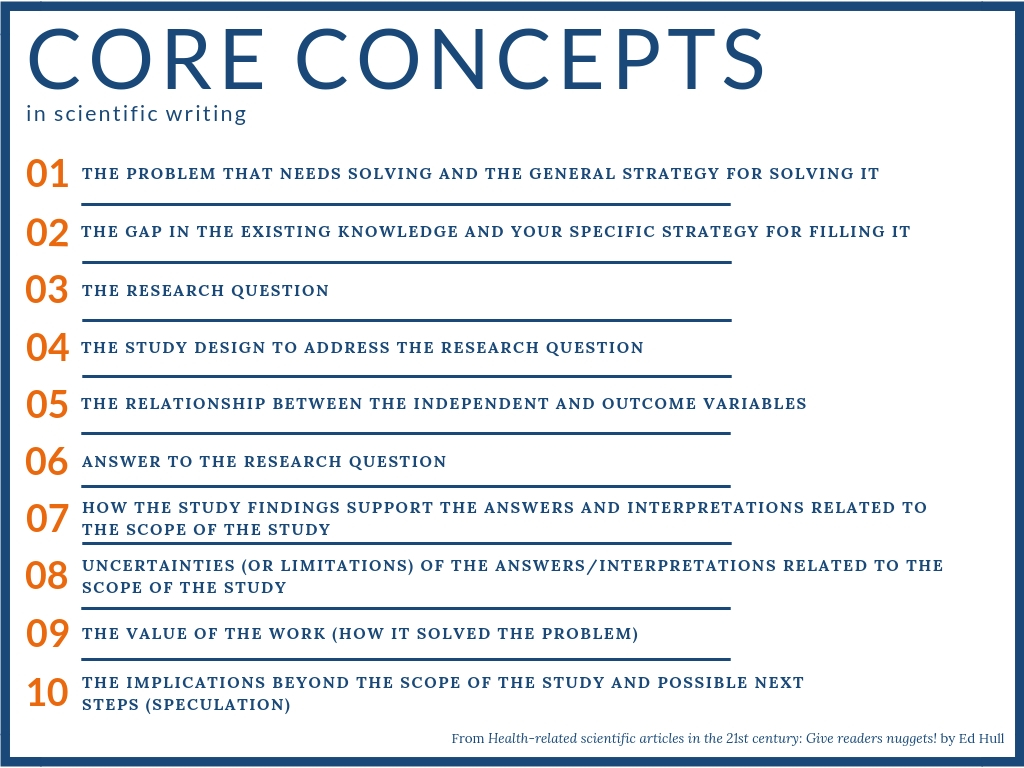
Ed guides his reader through these core concepts, explaining each one in detail and using examples of fictitious studies to show the reader exactly how to write each core concept. There is continuous emphasis on leaving out details and being clear, which is a good thing as many scientists tend to get bogged down in unnecessary details. With this template of core concepts, Ed’s readers have the basis for writing a well-structured Introduction and Discussion. There is also a chapter on how to write the Methods and Results sections of a research paper, and how to structure these sections logically using subheadings, as well as another chapter on how to give the title and abstract maximum impact.
Specific focus
As he guides the reader through his writing strategy, Ed gives plenty of useful tips. One of the most useful (in my opinion) is the instruction to specify the scope of your study. This may seem rather obvious, but many scientists are afraid to – and don’t – do this. They feel that by narrowing the scope of their study, their findings will seem less important and less interesting. This fear is understandable, considering how much pressure scientists are under to publish, publish, publish in journals with the highest possible impact.
But Ed sensibly points out that focusing on a specific scope actually increases the credibility of a study in the mind of the reader because the author does not fall into the trap of mistakenly implying their study is bigger than it actually is. By maintaining this all-important focus, the methods will adequately address the scope of the study and the results will be credibly generalizable to the specific study population. A knock-on effect of this is that scientists will be less reluctant to acknowledge the limitations of their studies, thereby promoting accountability and research integrity.
This is one valuable golden nugget that I will be passing on to my own clients.
Getting the structure right
Ed’s strategy for writing research manuscripts helps solve another common problem among scientists: considering the overall structure of the manuscript and putting the right information in the relevant section. It may seem obvious what should go into the Introduction, Methods, Results and Discussion sections, but for some reason, authors of research articles often wind up interpreting their findings in the Results section, repeating their results and background information in the Discussion, or not answering their specific research question at all.
Ed helps researchers forget about details and focus on their take-home messages when writing their papers. Explaining each of these messages clearly and explicitly means the reader can focus on the scientific content of the research paper instead of struggling to find the point.
How to be reader friendly
A reader will have an easier time understanding an article that is well structured not only at the document level, but also at the paragraph and sentence levels. To help his reader break the habit of writing in a pompous, archaic style that is difficult to understand, Ed provides 10 helpful techniques for structuring reader-friendly sentences. He makes a concrete case for using the active voice and warns against ambiguous verbs and empty phrases that can leave the reader guessing. He also explains how to structure these reader-friendly sentences into logical paragraphs that tie the story together in a way that makes the reader want to keep reading (Ed provides a list of useful connecting words and phrases in the Appendix, which will be particularly useful for ESL authors). Ed illustrates each of his tips and techniques with helpful examples.
Much needed help
Ed has drawn on his experience as a researcher and teacher of scientific writing to develop an effective strategy for writing clear, well-written research articles – something which is sorely needed in academia. His ideas are well presented and easy to follow and should benefit native English-speaking and ESL authors alike. The book accompanies a successful writing course for PhD students that is held eight times a year at AMC in Amsterdam.
Ed’s book is also helpful to anyone who edits biomedical research papers. I for one am looking forward to passing on his wisdom to my own clients. Want to find out more? You can get your copy of Ed’s book here.
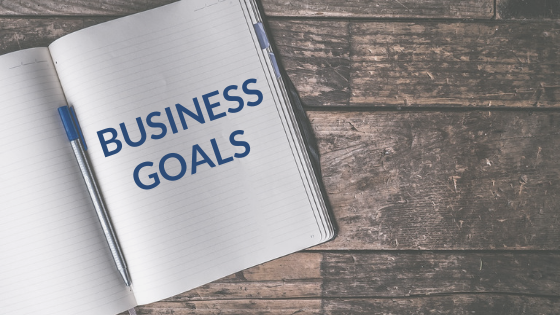
It’s time again to put Christmas behind us and get back to work. January is always full of fresh possibilities, and most of us are setting new goals for the year ahead. In this post, we catch up with two members of our SENSE content team – Claire Bacon and Ruth Davies – to find out what they learnt in 2018 and how this influenced their business goals for 2019.
How long have you worked as a language professional?
Claire: I used to work as a research scientist at the University of Heidelberg in Germany. I quit academia and set up my editing business back in September 2015. Now I use my research expertise to help non-native English-speaking scientists get their research published in peer-reviewed journals.
Ruth: I have been editing for around 15 years; before that, I taught linguistics for a few years, working with Aboriginal and Torres Strait Islander people from all over Australia. I own my sole trader (ZZP) freelance editing business, which I’ve been working in seriously since 2012. I mostly edit research reports in the topic areas of primary production, climate change and remote Australia.
What were your business successes in 2018?
Claire: At the start of last year, my editing business was still a baby. Now it’s more like a toilet-trained toddler that can dress itself. This is all down to the time I invested in editing training last year. I successfully completed three courses run by the Society for Editors and Proofreaders (SfEP) – Copyediting Headway, Medical Editing, and Brush Up Your Grammar – and this increased my confidence no end! It was probably thanks to these qualifications that I was hired by Springer as a copy-editor for one of their biomedical journals. I was recommended for the job by somebody in my professional network (yes, networking really pays off!) and after looking at my CV, they offered me the job.
Ruth: This year was much the same as in previous years, but the conditions were more difficult, so this feels like a success of sorts. I was very busy in 2017 with work, convening the Institute of Professional Editors (IPEd) conference (which was held in Brisbane in September), and then moving to the Netherlands with my partner in October. In contrast, this year has been relatively quiet.
Looking back, I’m most proud of being able to work hard to solve problems for clients, even in tight timeframes. I took the opportunity to do a little more professional development and have done massive open online courses (MOOCs) about grammar (a refresh), social media marketing (new and scary) and corpus linguistics (fascinating). Of course, I also attended the SENSE conference and have had some work through the SENSE forum.
And what lessons did you learn?
Claire: I learnt that continued effort is necessary for marketing to pay off. Marketing is all about making sure that people know what you can do. I’ve started blogging regularly and getting more involved in networking. It took about six months before I noticed the effects. I learnt that you just have to keep at it and that (annoyingly enough) clients won’t find you unless you make yourself visible.
I also learnt how to prioritize. My working time is limited and I realized that something had to give. I stopped doing low-paid editing work for agencies, focusing instead on building my own client base and being there for my children. I also learnt how to say no to people who do not want to pay you the rate you are asking for.
Ruth: First of all, I learnt that a balance is needed between looking for new work, doing voluntary work and doing work. I worked hard on my professional development, but I now realize that if I put the same amount of effort into chasing new work as I did into MOOCs, I’d probably have more work. The same applies to doing voluntary work, which I do for IPEd and for a women’s group I’m a member of here in Utrecht.
Second, I learnt the importance of identifying gaps in production processes. I had a job this year that lasted a long time because the production process went a little awry. While my role was not that of production editor, I should have seen the gap and made sure everyone had all the information.
What are your business goals for 2019?
Claire: I will continue to work on my professional development. I want to learn how to be more efficient with my editing, so will take a course on editing with Word. I also aim to gain professional membership of the SfEP, which will allow me to be listed in their directory of editorial services. For professional membership you need to prove you have sufficient training and experience and you have to provide references, so it really proves your worth as an editor. I also plan to increase my marketing efforts and put more time and energy into developing my blog, which will hopefully bring in more clients.
Ruth: The focus for me will be on building up my client base by putting the social media marketing course I did this year to better use. I’ll also try to use the corpus linguistics method to inform my blog articles for 2019. In May, IPEd will be holding its next conference in Melbourne, so I’ll make that my main professional development activity.
What are your business goals for 2019? Why not share them by posting a comment below?

We all know the importance of professional development, and taking an online editing course is a great way to improve your editing skills. But how do you decide which course(s) to take? In this blog post, Claire Bacon reviews the SfEP’s Copy-editing Headway course.
The need for training
I am an ‘invasive species’ in the editing world. I did not set out to become an editor – instead, I spent more than a decade working as a research scientist. My postdoc years were spent in Germany, and I soon realized that lots of non-native English-speaking scientists need help getting their research published. Indeed, I spent many hours editing manuscripts for my colleagues. I realized that not only did I enjoy it, I was good at it, and my fate as a language editor was sealed. Bye-bye lab, hello working at home in my pyjamas!
Sure, research experience and subject knowledge are very helpful if you want to edit academic papers. But that’s not all it takes. Editing requires a very specific set of skills – and these skills need to be learned.
The start of 2018: getting in (editing) shape
My professional goal for 2018 was to sharpen my editorial skills. I reached out and asked the editing community which courses I should take, and received countless recommendations for the online courses offered by the SfEP – the UK-based Society for Editors and Proofreaders.
I was not a complete beginner to editing and was looking for a course that could take my copy-editing skills to the next level rather than teach me the basics. Copy-editing Headway, the SfEP’s intermediate copy-editing course, seemed like the perfect choice. It is not aimed at complete beginners, but rather at those who already have some copy-editing experience. And it promised to expand my knowledge of the principles and practices of copy-editing. Sounded good.
I quickly felt like I was getting value for my £130 plus VAT. Within 24 hours, I had access to the study notes and exercises, as well as a Resources Centre, which includes a glossary of editing terminology and an explanation of the differences between copy-editing and proofreading. Access to the course materials is granted for 6 months, and although I was worried at first, I found that this was more than enough time to complete the course – even with some unexpected life events thrown in! And it gave me the motivation I needed to get the course done.
I was assigned my very own tutor – Leah Morin – whose job it was to mark my assignments and answer any questions. Leah is an advanced professional member of the SfEP and has a wealth of copy-editing experience, so I was in very good hands.
Course structure
Copy-editing Headway is divided into five sections. Each section comes with study notes that explain what you need to know to complete the task. Sections 1, 3 and 5 include assignments which are graded by your tutor, and sections 2 and 4 contain exercises that are self-assessed based on a model answer. Your final grade is based on the marks you get from the three marked assignments.
Each section deals with a different topic:
• The first section summarizes everything you should already know about what a copy-editor does and the concepts of good working practice. For the assignment, you are asked to copy-edit a short text from a Christian charity’s newsletter and code/tag the text features for the designer.
• The second section focuses on displayed matter, which are textual features that are not part of the main text body such as headings, lists and quotations. In the exercise, you have to code the text features in a book chapter about non-sexist language and provide a list of instructions for the typesetter.
• The third section deals with the presentation of words, punctuation, and numbers, and how to ensure consistency in editorial style using a style sheet. To test your skills, you are asked to copy- edit and make a comprehensive style sheet for a sample from a book about Jane Austen and her social world.
• The fourth section explains how to edit bibliographies and what to look out for (such as organization of references and citation style). You have the opportunity to test your attention to detail by editing a short bibliography that is filled with irritating inconsistencies.
• The fifth and final section discusses the different types of images and what we, as copy-editors, need to check when editing a text that contains images (such as numbering and referring to figures, editing figure captions and ensuring that all image sources are properly acknowledged). For the assignment, you are asked to copy-edit the text and captions from a book chapter about the history of landscape. The chapter includes two figures and an illustration, which need to be cued into the text.
Overall, I was satisfied with the course structure. There were a variety of texts to practise on, none of which were scientific or medical, so completely new territory for me. It was reassuring to have a qualified tutor assess my editing work in detail. On the other hand, assessing my own work by means of a model answer was also a valuable exercise, as it emphasized the areas I needed to work on.
What did I learn?
I learned how copy-editing for a publisher works. Although I work as a freelance editor and principally edit biomedical research papers for non-native English-speaking scientists, you never know what the future holds and I did find these new insights useful.
For example, I had no idea what a typesetter does, or how to code/tag text features for the designer. Leah was very helpful and sent me a list of codes and explained how to insert them properly into the text. She also explained that coding requires a systematic approach, taking several passes, checking one thing at a time.
I also learned how to use standard proofreading symbols when copy-editing on hard copy – something I have never done before because my clients all want their research manuscripts editing in Word using Track Changes. I found using the symbols oddly satisfying, and although my clients are unlikely to ask me to mark up a hard copy of their research manuscript, it is reassuring to know that I could now do so if asked.
Working through the assignments showed me that good editing depends on how you approach the work. Before, I would take two or three detailed passes on a text, each time looking for any mistakes. While I was able to produce good-quality edits with this method, the course exercises showed me that focusing on specific points during each pass really helps catch errors that may otherwise be missed.
Would I recommend the course?
I would certainly recommend the course, particularly to those who want to work for a publisher. Copy-editing Headway has given me a deeper insight into how copy-editing works in the publishing industry and I am more aware of the specialist skills and terminology involved. Having passed the course, I now have the option to take the advanced copy-editing course (Copy-editing Progress) and potentially move on to the mentoring programme. This sounds enticing, but I will first focus on courses that are more closely related to the type of editing I do. Watch this space for my upcoming review of the SfEP’s Medical Editing course!
Claire Bacon is an editor and writer for the SENSE blog and a research scientist turned editor who runs a business called Bacon Editing.
Have you recently taken a professional development course? Why not share your experiences in the comments below? Or you can contact our Content Manager and write a blog article of your own!
 Writing blog articles is a great way to gain exposure and practise your writing skills. If you produce interesting content, you will engage with people and create new opportunities. Marianne Orchard explained how to structure a blog article and make it easy to read in her post published on the SENSE blog earlier this month. Now you know how to write a blog post, you may be wondering what you can write about. Believe it or not, inspiration is everywhere. In this post, I explain how to find enough blog ideas to keep you writing for months.
Writing blog articles is a great way to gain exposure and practise your writing skills. If you produce interesting content, you will engage with people and create new opportunities. Marianne Orchard explained how to structure a blog article and make it easy to read in her post published on the SENSE blog earlier this month. Now you know how to write a blog post, you may be wondering what you can write about. Believe it or not, inspiration is everywhere. In this post, I explain how to find enough blog ideas to keep you writing for months.
Problem solving
Good blog articles solve a problem. Think about your target audience – as a language professional your target audience is most likely to be your clients or your peers. What problems do they have? Do you have a solution? If you do, then your reader has a good reason to read your blog.
I write my blog for my clients, who are non-native English-speaking scientists. Many of my ideas come from problems with my clients’ writing. These issues are common among ESL authors – poor paragraph structure, no clear metastructure, redundant information disrupting the flow... and so on. These challenges and their solutions have all made useful blog articles for my clients.
Answer your clients’ questions in a blog post. For example, a client of mine was not sure whether her manuscript needed copyediting or substantive editing. This inspired me to write a post that explained how authors with no real knowledge of editing can determine the appropriate language service for their manuscript.
If you are writing for your fellow language professionals (editors, translators, interpreters, teachers), think about want they want to know. Chances are you know of a problem or two they may be having that you can solve. Maybe you have a few tips on how to handle difficult clients, or how to survive the highs and lows of freelancing? Perhaps you are a computer whizz and can explain how to get the most out of editing software. Share your knowledge and experience.
What’s new?
There is always something to write about. There are new ideas and new developments in every field – you just have to find out what they are. Read relevant publications and follow your colleagues and clients on social media to find out what topics are interesting to them at the moment. Or interview someone who is authoritative in your field about a pressing issue. Don’t get hung up on writing about something that others have already written about – if you have a different take on the subject, put it out there.
Did you try a new product or service recently? Think about writing a review. Maybe you finished an online training course. Tell your readers what you learnt. Don’t vent dissatisfaction in your post – aim for a balanced, honest review that informs the reader and draws clear conclusions.
Conversation can give you great ideas for a blog post. Think about the last time you got into a debate with a colleague or client. Would others find your discussion interesting or useful? Then why not present a balanced argument and share your opinions in a blog post? I got into a discussion with a young researcher some weeks ago about using simple words instead of obscure ones when writing a research manuscript. He was adamant that longer, complicated words and sentence structures are better because they sound clever and are ‘more academic’ (sigh). I argued on behalf of his poor reader. This discussion inspired a blog post on writing for your reader.
Conferences are always a great source of blog material. What interesting things did you learn at the last conference you attended? Why not share your experiences in a blog post? The challenges facing academic editors was a popular topic at the SENSE 2018 conference in June and made me think of my clients and how insights from language editors can help them get their work published. Great blog material.
Get blogging!
Hopefully the tips outlined in this article have given you plenty of ideas for interesting blog articles. If you don’t want to start writing your own blog – maybe because you don’t want the pressure of publishing articles on a regular basis – then why not write for the SENSE blog? We are always looking for new contributors. Our articles are shared widely on social media so writing for us is a great way to increase exposure for your business.
Get in touch with the SENSE Content Manager if you would like to post your next article on the SENSE blog. We look forward to hearing from you. And please share any additional tips you may have on finding ideas for blog posts in the comments below!
Claire Bacon is an editor and writer for the SENSE blog and a research scientist turned editor who runs a business called Bacon Editing.
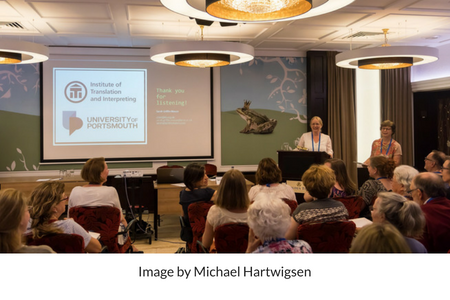 A call to arms
A call to arms
Sarah Griffin-Mason gave an illuminating plenary talk at the SENSE 2018 conference: 'Trends in translating and interpreting to 2050.’ Claire Bacon caught up with her a few days after the conference to find out more.
We are experiencing an onslaught of rapid technological development. The rise in automation translation technologies may have left you wondering how we can survive in this ever-changing world. ‘We have to adapt’, Griffin-Mason told us.
In her plenary talk, Griffin-Mason, Chair of the UK’s Institute of Translation and Interpreting, discussed how improvements in machine translation may affect language professionals in the future and how we can push back. Her message was based on information gleaned from the International Federation of Translators meeting in August 2017, where a number of leading issues affecting language professionals were discussed. So what are the threats and what are our options?
Rise of the machines
Artificial intelligence is a leading concern for language professionals. But could we really be replaced by machines in the future?
Futurist Ray Kurzweil seems to think so. In his book The Singularity is Near, Kurzweil talks about how an exponential increase in technologies will eventually culminate in the Singularity – a point when technology will merge with human intelligence. Once the Singularity has been reached, machine intelligence will master human intelligence and effectively take over.
So where does that leave us? It is hard to imagine that the ambiguity and flexibility of human language can be accurately translated by a machine with no understanding of the world.
Lucky for us, computer language translation will be one of the last technological applications to compete with humans. In his book, Kurzweil acknowledges that dealing with language is the most challenging task for artificial intelligence because it cannot understand the context of words or how a text works. Despite this, he predicts that machine translation will be good enough to replace many human translators by 2029.
Machine learning
New approaches to automated translation are bridging the gap between human and machine translation. Neural machine translation uses artificial neural networks that mimic the human brain to predict word sequences and generate sentences. But is this new approach really as good as human translation?
Microsoft researchers recently claimed to have created a machine translation system that achieved human parity when translating certain segments of a Chinese news bulletin into English. Human parity was assessed by bilinguals (not translators) who compared a set of machine translations with the corresponding human translations. No statistically significant differences were observed between the human translations and machine translations.
But before we hand our jobs over to the machines, it is important to note that this result was restricted to a specific set of translations. It is still not clear whether machine translation systems can translate any text in any language pair as well as a professional human translator.
Machines need people
‘The key issue’, says Griffin-Mason, ‘is that human processing and use of language are not the same as machine processing and use of language. Furthermore, machines need people – automated translation systems will need to be tested and refined by language experts.’
In an article for The Economist, Robert Lane Greene has argued that machine translation will always need to be quality controlled by humans because, no matter how sophisticated a computer is, it will never be able to truly understand the meaning of a text. Editing is already an important part of what translators do and, Greene says, may become far more important as artificial intelligence and machine translation improve and expand.
‘The surviving paid roles in the future’, says Griffin-Mason, ‘will be those that require soft skills and quality control that are beyond the scope of what machines can do’.
A call to arms
The challenges we face as language professionals are real. If we do not guard against them, the exponential advances in technology will weaken translation and editing expertise, combining with the gig economy model in a way that will be even more challenging for future generations. Griffin-Mason issued a call to arms on behalf of translators everywhere: to defend our profession.
First and foremost, we need to start raising the profile of translation as a professional service that is essential to our clients – and we need to emphasize what we can do that machines cannot.
‘Good translation is so much more than knowing a language’, Griffin-Mason says, ‘it requires specialist knowledge of the subject being translated, the purpose of the document being translated and cultural sensitivities’. Machines do not possess this knowledge and understanding.
We can propagate the message that human translation is important by joining a professional entity and getting involved in conversations. Write articles, join in debates on social media, give speeches. It is our job to defend our profession; nobody is going to do it for us.
Griffin-Mason’s message is very clear: we must not quit. What we do need to do is to prepare for and adapt to the forthcoming challenges. Whatever it takes.
Want to know more? Read The Singularity is Near by Ray Kurzweil to understand the full force of what could be possible. If this motivates you to take a stand, then read WTF?: What’s the Future and Why It’s Up to Us by Tim O’Reilly to learn how to get in on the conversation and help shape our future.
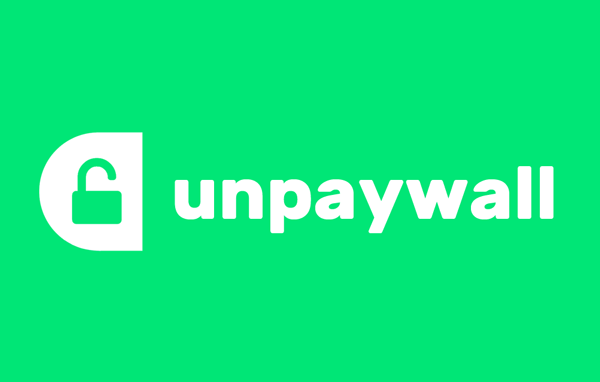 As a scientific language editor, I often need to browse articles when editing. But without a university/institute subscription, getting free access to the literature can be tricky.
As a scientific language editor, I often need to browse articles when editing. But without a university/institute subscription, getting free access to the literature can be tricky.
Although the number of open-access journals is increasing, many articles are still locked behind ‘paywalls’. This means that to read the full text of a particular article, you have to purchase it, or subscribe to the journal for a hefty fee. I doubt my clients will accept that add-on cost.
But free versions of paywalled articles are sometimes available, for example if the author has uploaded it elsewhere. Impactstory is a non-profit open-source, web-based service committed to making research data freely available to all. In April last year, they introduced Unpaywall, a web browser extension that can retrieve open-access articles immediately and automatically. For free.
Unpaywall can be installed into Google Chrome or Mozilla Firefox browsers. It takes seconds and you don’t even have to restart your computer. It works automatically, while you browse, so no need to insert the article’s DOI into a search box. And don’t worry: Unpaywall only retrieves articles from legal sources.
It’s pretty user friendly. A few seconds after finding an article, an Unpaywall symbol will appear at the side of your screen. If an open-access version of this article is available elsewhere, a green unlock symbol will appear. Clicking on this symbol allows you to read it for free. A grey lock symbol tells you that no open-access version was found. Unpaywall finds a free version at least 50% of the time, which makes life a little easier (and cheaper) for the self-employed language editor.
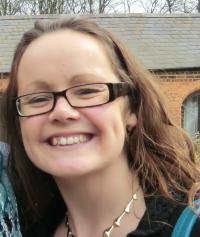
 The more editors I meet, the more I realise that many of us fall into the profession by ‘accident’. I certainly did not set out to become an editor – my background is in neuroscience and human genetics and I thought I would wind up being a professor with my own research lab.
The more editors I meet, the more I realise that many of us fall into the profession by ‘accident’. I certainly did not set out to become an editor – my background is in neuroscience and human genetics and I thought I would wind up being a professor with my own research lab.
But three years after leaving research, I am the proud owner of an editing business that is doing pretty well and I love my work. Changing career path can be pretty daunting. Sometimes it helps to hear what people in the same boat have to say. In this article, I share what I have learned in the last three years.
Finding work
Starting out as a freelancer, the big question on my mind was: where will I find work? As a native English speaker working in a German lab, I had been editing papers for my colleagues for years so already had a handful of clients. But I didn’t have enough work lined up to pay the bills.
To ensure a reliable source of income, I joined an editing agency. They sent me regular assignments and although the editing rates were not great, I was gaining valuable experience, earning some money, and was free from the pressures of self-marketing.
However, I realised that the client can learn a lot more from the editing process when he/she has direct contact with the editor. So after a while, I decided to take the leap, quit agency work, and invest time in building up my own business: Bacon Editing.
Online presence and content marketing
Most people search the Internet for products and services, so I created a website for Bacon Editing. At the SENSE Professional Development Day last September, Theresa Truax-Gischler talked about how to build your content marketing strategy around a hub-and-spokes model.
The spokes (Facebook, Twitter, LinkedIn, etc.) can all be used to drive traffic to the hub (your business website). I began to use my Facebook and LinkedIn accounts to share content and promote my business.
To enhance my marketing efforts, I started to write a blog. A good blog needs a defined niche and target audience. I edit pre-submission research papers for ESL scientists and clinicians and was coming across the same issues again and again with my clients’ writing. I decided that my blog posts would tackle these common problems.
Writing a blog has promoted my business. Sharing my articles on social media drives people to my website and connects me with other editors. It also gives me a reason to touch base with my existing clients; each month, I email them my blog articles and usually get a job or two in return.
Training and mentoring
Nobody is too talented to learn more. I have the necessary scientific expertise to understand my clients’ work but I was no grammar expert when I started editing.
To strengthen my profile as a language editor, I took an online editing course. Professional training is not essential for freelance editing, but most experienced editors strongly recommend it. The editing course was a good choice for me; it gave me the knowledge I needed to explain and justify my corrections to clients and motivated me to continue with more advanced courses.
One of the best ways to learn how to build a successful editing business is to talk to people who already have a successful editing business. Curtis Barrett took time out of his busy schedule at the SENSE Jubilee conference in 2015 to explain how he made a success of English Editing Solutions in just a few years.
One valuable piece of advice was to have confidence in your abilities as an editor and not compromise on your rates. Curtis encouraged me to quit agency work and go after clients who are willing to pay the fees I deserve, which was definitely a push in the right direction.
If you are very lucky, you will connect with someone who is prepared to invest considerable time in your success. I met Ragini Werner (owner of NEEDSer and former eSense editor) at the SENSE Jubilee conference and she has gone above and beyond to help me become a better editor and writer.
Ragini checked through several of my completed edits, encouraged me to write for eSense, gave feedback on my website, and provided invaluable support when I set up my blog. She also trusted me enough to leave her clients in my hands while she recovered from knee surgery earlier this year.
This mentor-mentee relationship has boosted my professional development and I am extremely thankful to have Ragini on hand to offer advice. That’s what networking can do for you.
It’s all about networking
We all know that networking is one of the best ways to find clients. That’s why we join societies, go to conferences, and participate in online forums. Sally Hill talked in depth about the hidden value of your personal network at the Professional Development Day last year.
‘Prepare a few choice phrases about who you are and what you do,’ Sally told me over lunch, ‘then you will be able to give a good answer when people ask about your work in social situations’.
This was excellent advice, particularly because I have most of these conversations in German (my second language). After Sally’s talk, I decided to explore my personal network a little more.
At the playground, I started to talk to other mums about my work instead of just teething problems and tantrums. I live in Heidelberg, one of the top research cities in Germany, and it occurred to me that some of the mothers building sandcastles and wiping snotty noses could be research scientists on maternity leave, or know people who work in research.
Sure enough, I gained two regular clients from chatting to mums. I also exploited my husband’s connections as a maxillofacial surgeon to get work (now he always attends conferences with a pile of my business cards). As Sally promised, capitalizing on my personal network was a great way to generate business.
A local professional network – people you can meet with face-to-face to discuss work-related issues – is also important, particularly if you work from home. I met some fellow language professionals at a networking event run by the Heidelberg International Professional Women’s Forum, and initiated an informal language meet-up.
Our small group now includes editors, translators, interpreters, and teachers and we meet up regularly for informal work-related discussions and to share our services.
The road to success
Starting a business from scratch may seem daunting at first. Hopefully, some of the tips outlined in this article will help you make the jump from beginner to successful entrepreneur.
